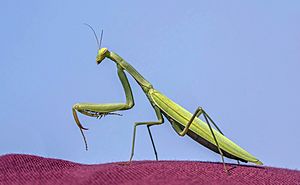European mantis facts for kids
Quick facts for kids European mantisTemporal range: Piacenzian – Recent
|
|
|---|---|
 |
|
| Adult female, Romania | |
| Conservation status | |
| Scientific classification | |
| Genus: |
Mantis
|
| Species: |
religiosa
|
| Subspecies | |
| Synonyms | |
|
|
The European mantis (Mantis religiosa) is a large insect. It belongs to the mantis family, which is the biggest family in the mantis group. These insects are known for their unique look and hunting skills.
Contents
- About the European Mantis
- How the European Mantis Sees
- Behavior of the European Mantis
- Where European Mantises Live
- Reproduction and Life Cycle
- Larval Development
- What European Mantises Eat
- Lifespan of the European Mantis
- Conservation Status
- Cool Facts About the European Mantis
- Subspecies
- Images for kids
- See also
About the European Mantis
Both male and female European mantises have long bodies. They also have two pairs of wings. Females are usually bigger and heavier than males. Females are about 7–9 cm long, while males are 6–7 cm. However, males have larger antennae and eyes. Males are often more active and quick. Females are physically stronger.
The most noticeable part of a mantis is its head. It is triangular and can move a lot. It has large compound eyes. Their front pair of legs are called 'raptorial legs'. These legs are strong. They help the mantis catch and hold fast-moving or flying prey.
European mantises come in different colors. They can be yellow, brown, green, or sometimes black. Scientists have studied why they have these colors for over 100 years. But they still don't have a full answer.
In 1904, a scientist named Di Cesnola noticed something interesting. Green mantises were found on fresh green grass. Brown mantises seemed to prefer brown, dry grass. When mantises were moved to a place that did not match their color, many were eaten. Predators like birds killed them. This shows that their color helps them blend in with their surroundings.
Scientists also found that temperature can change their color. Mantises born in a cold place turned green after shedding their skin. This happened when they were given heat and sunlight. If only the background color changed, their own color did not.
How the European Mantis Sees
Mantises have big compound eyes. These eyes make up a large part of their head. They hunt mostly by sight. They are very good at spotting movement.
The eyes of the European mantis work best in daylight. An adult mantis has 8,000 to 10,000 tiny eye units. These units are called ommatidia.
Mantises often move their heads or bodies from side to side. This is called 'peering behavior'. Scientists think this helps them measure distances. It also helps them see how far away things are. If a mantis was blind in one eye, it could not catch prey. This shows that seeing with both eyes is very important. It helps them figure out distances.
Young mantises, called nymphs, have smaller eyes. Their eyes are less than half the size of adult eyes. They also have fewer ommatidia. The front parts of their eyes are not fully grown yet. These parts are usually used to spot partners and prey. Young mantises have all the right eye parts. But their vision is not as good. It improves a lot after just three days.
Behavior of the European Mantis
When a mantis feels threatened, it has a trick. It spreads its wings wide. It also bends its front legs. This shows two black spots that look like eyes. These spots have a yellow or white center. They are at the base of its legs. This makes the mantis look much bigger and scarier. This trick gives the mantis a chance to escape from attackers.
Where European Mantises Live
M. religiosa can be found in many places. These include Europe, Asia, and Africa. They are also found in North America. In North America, they were brought there by people. There are two confirmed groups of them in Germany. One is in Rhineland-Palatinate and one in Baden-Württemberg. Recently, more reports show them spreading to Northern Europe. This includes Latvia and Estonia.
Reproduction and Life Cycle
For M. religiosa, finding a mate happens in two steps. First, they see each other. This is the start of courtship. It ends when they first touch.
Only a few days after becoming adults, they start looking for a mate. Males are most attracted to females in the middle of the day. This is when it is hottest.
If a female sees a male, she might attack and kill him. So, males are very careful when they approach. After a male sees a female, he usually stops moving. He turns his head to look right at her. His eyes are best for looking straight ahead. This gives him a very clear view of her. He can watch her every move. Then, he tries to get close to her from behind. Males will stop if the female turns her head or even moves.
The male uses this 'stop-and-go' method to get closer. This can take several hours. Sometimes, males will rock slightly. This is thought to help them look like leaves. It helps them blend in with plants around them. Males who did this were not more likely to be seen or attacked.
After mating, the male lets go of the female. He drops to the ground to get away from her. He moves about 50 cm away. Then he stops and freezes for about four minutes. After that, he leaves.
Larval Development
On average, it takes 11 days for the female to make and lay an ootheca. This is a special egg case. It holds about 100 to 200 eggs.
Egg-laying usually happens in September or October. But the eggs stay in the ootheca over winter. The young mantises, called larvae, don't hatch until the next spring. Hatching depends a lot on the environment. It needs a temperature of at least 17 °C and enough moisture. Females like to lay their eggs on strong surfaces. They choose warm and sunny spots. Most eggs from one ootheca hatch at the same time. They always hatch in the morning.
Larvae go through several stages as they grow. Each stage ends with a moult. This is when they shed their old skin. After the eighth moult, the adult mantis appears. It now has wings and is fully grown. M. religiosa has never been seen to moult more than eight times. But females usually need one more moult than males.
What European Mantises Eat

M. religiosa is a carnivorous ambush predator. This means it eats other animals. It actively looks around for food. It eats most insects that are not too big for it to catch. It catches them by quickly extending its front legs. It only catches and eats living, moving prey right away. Grasshoppers seem to be a favorite food. This is probably because of how they move. But crickets and cockroaches are also often eaten.
Once prey is caught, it is trapped and cannot move. The mantis then starts eating the prey. The prey is usually still alive and moving.
Lifespan of the European Mantis
How long a European mantis lives depends on many things. This includes its species and size.
- In the wild, a praying mantis lives for about 10-12 months.
- The lifespan also depends on the species. Smaller ones might live 4–8 weeks. Larger species can live 4–6 months.
- Male European mantises usually live shorter lives than females. Males live 7–8 months. Females live 11–12 months.
- In captivity, European mantises have been known to live up to two years.
- Adult mantises brought indoors before winter frost might live a few months longer. But they will die of old age before spring.
Conservation Status
In Germany, M. religiosa is listed as Gefährdet. This means it is endangered there. This was based on a study from 1998. People are not supposed to catch or keep them as pets in Germany. But around the world, the IUCN says it is of least concern. This means it is not currently at risk globally.

Cool Facts About the European Mantis
- Their common name, praying mantis, comes from how their front legs look. They hold them in a way that looks like someone praying.
- The European mantis has a special ear. It is found on the underside of its body. It is between its third pair of legs. This ear can hear many different sounds. It can even hear ultrasound. It is called a 'true ear'.
- It is the official state insect of Connecticut.
- Mantises are very good at seeing things that move. But they can barely see objects that are not moving.
- They can eat each other. Because of this, if you keep them as pets, you usually need to keep them alone.
- Mantises that are not yet adults are called 'nymphs'.
Subspecies
- M. r. beybienkoi is found in Kazakhstan, Tajikistan, Mongolia, West Siberia, and Primorsky Krai (Russian Far East).
- M. r. caucasica is found in Stavropol.
- M. r. eichleri is found in Ethiopia, Mauritania, Niokolo-Koba, Ghana, Cameroon, Kenya, the Congo, Niger, Senegal, Somalia, Sudan, Tanzania, Togo, Zimbabwe, Burkina Faso, Zambia, and Anatolia.
- M. r. inornata is found in India, Iran, Nepal, and Pakistan.
- M. r. langoalata is found in Uzbekistan.
- M. r. latinota is found in Kazakhstan.
- M. r. macedonica is found in North Macedonia.
- M. r. major is found in Mombasa (Kenya).
- M. r. polonica is found in Poland and Russia.
- M. r. religiosa is found in Africa, North America (Canada, United States), Europe, and Asia (Nepal). It is not found in South America or Australia.
- M. r. siedleckii is found in Southeast Asia: Taiwan, Thailand, Malaysia, Java, and Sulawesi.
- M. r. sinica is found in China, Japan, Korea, Myanmar, and Vietnam.
Images for kids
-
A young M. religiosa nymph in France
-
A mantis at the Aristotlepark of Stagira
See also
 In Spanish: Santateresa para niños
In Spanish: Santateresa para niños




















